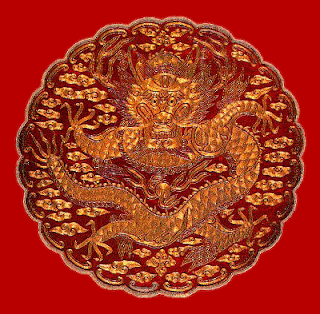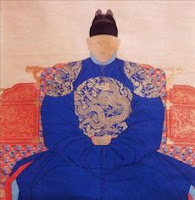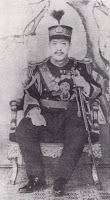Sunday Deposed Monarch Blogging: Joeson Dynasty
 In the second half of the 14th the rulership of northeast Asia was in a state of flux. The Mongols ruled China as the Yuan Dynasty until 1371, when they were replaced by the Mings and chased back to Mongolia. This had the effect of seriously weakening the rule of the Korean royal house, which had survived under the occupation of the Mongols. The son of a minor Mongol official of Korean descent, Yi Seong-gye rose to prominence as a general in the disorder that accompanied the disintegration of Mongol power. After fighting off Mongol remnants and major expeditions by Japanese pirates, Yi Seong-gye turned his interest inward, and deposed the 500 year old Goryeo dynasty. In 1392 he established a new dynasty, claiming connection with the Joeson, an ancient, near-legendary Korean family. He took the name King Taejo, but remains a controversial figure because of his close association with the Ming.
In the second half of the 14th the rulership of northeast Asia was in a state of flux. The Mongols ruled China as the Yuan Dynasty until 1371, when they were replaced by the Mings and chased back to Mongolia. This had the effect of seriously weakening the rule of the Korean royal house, which had survived under the occupation of the Mongols. The son of a minor Mongol official of Korean descent, Yi Seong-gye rose to prominence as a general in the disorder that accompanied the disintegration of Mongol power. After fighting off Mongol remnants and major expeditions by Japanese pirates, Yi Seong-gye turned his interest inward, and deposed the 500 year old Goryeo dynasty. In 1392 he established a new dynasty, claiming connection with the Joeson, an ancient, near-legendary Korean family. He took the name King Taejo, but remains a controversial figure because of his close association with the Ming.
 Twenty-six kings of the Joeson dynasty would rule Korea over the next 504 years. Korea under the Joeson successfully turned away a pair of Japanese invasions in the late 16th century, and a Manchu invasion in 1627. During the former, the Koreans employed turtle ships, cannon-armed covered warships resistant to small arms fire. A second Manchu invasion in 1636 (shortly before the Qing Dynasty assumed power in China) reduced Korea to tributary status, where it would remain for roughly 250 years. The Joeson failed, however, to modernize in the 19th century at the same rate as the Japanese. A French punitive expedition in 1866 occupied some Korean territory, and two American raids killed many Koreans. The central threat remained the Japanese, however; Japanese victory in the 1894 Sino-Japanese War made Korea the field of a contest for influence between Russia and Japan. The Japanese assassinated the wife of King Gojong in 1895 after she sought Russian assistance.
Twenty-six kings of the Joeson dynasty would rule Korea over the next 504 years. Korea under the Joeson successfully turned away a pair of Japanese invasions in the late 16th century, and a Manchu invasion in 1627. During the former, the Koreans employed turtle ships, cannon-armed covered warships resistant to small arms fire. A second Manchu invasion in 1636 (shortly before the Qing Dynasty assumed power in China) reduced Korea to tributary status, where it would remain for roughly 250 years. The Joeson failed, however, to modernize in the 19th century at the same rate as the Japanese. A French punitive expedition in 1866 occupied some Korean territory, and two American raids killed many Koreans. The central threat remained the Japanese, however; Japanese victory in the 1894 Sino-Japanese War made Korea the field of a contest for influence between Russia and Japan. The Japanese assassinated the wife of King Gojong in 1895 after she sought Russian assistance.
 In 1897, increasing pressure from the Japanese forced King Gojong to declare formal independence from China and establish the Empire of Korea. Gojong and his circle had bitterly resisted this move, since it amounted to a recognition that Japan would dominate Korean affairs for the foreseeable future. The Russo-Japanese War of 1905 further consolidated Japanese power, and led to a series of unequal treaties between Korea and Japan that left the former a virtual protectorate of the latter. Emperor Gojong protested these moves by sending representatives to the Hague Peace Convention of 1907, but these representatives were prohibited from speaking. The Japanese then quickly moved to force Gojong out; he abdicated to his fourth son, who became Emperor Sunjong. Sunjong’s reign was brief, as in 1910 the Japanese moved to end the fiction of Korean independence and enact a formal annexation.
In 1897, increasing pressure from the Japanese forced King Gojong to declare formal independence from China and establish the Empire of Korea. Gojong and his circle had bitterly resisted this move, since it amounted to a recognition that Japan would dominate Korean affairs for the foreseeable future. The Russo-Japanese War of 1905 further consolidated Japanese power, and led to a series of unequal treaties between Korea and Japan that left the former a virtual protectorate of the latter. Emperor Gojong protested these moves by sending representatives to the Hague Peace Convention of 1907, but these representatives were prohibited from speaking. The Japanese then quickly moved to force Gojong out; he abdicated to his fourth son, who became Emperor Sunjong. Sunjong’s reign was brief, as in 1910 the Japanese moved to end the fiction of Korean independence and enact a formal annexation.
Emperor Gojong died in 1919, and Emperor Sunjong in 1926. Sunjong was succeeded as head of the dynasty by his brother Euimin, who assumed the title Grand Prince. Euimin had a long career in the Japanese Army, serving in several capacities in World War II. After the war, Euimin sought to return to Korea, but this was blocked by Syngman Rhee. Some consideration was given in the United States to supporting a return of the Korean monarchy, but such efforts came to nothing. Euimin returned to South Korea in 1963, and died in 1970. Euimin was succeded by his son Gu, who died in 2005. The claim to the monarchy has since fallen into dispute, with claimants including Princess Haewon, the 88 year old niece of Emperor Sunjong, Prince Won, the 45 year old cousin and adopted son of Prince Gu (currently employed as the manager of Hyundai Home Shopping), and Prince Seok, a 66 year old cousin of Gu (currently employed as a history professor). The evidence seems to lean most heavily towards of the claim of Prince Won, but prospects for a return to the throne are grim in any case. Although the monarchy has some supporters in Korea, the taint of collaboration with the Japanese remains on the family. As far as I can tell there are no major monarchist parties in the South, and the Kim family remains in secure control of the north. Even allowing for the possibility of reunification, the return of the Joeson Dynasty (now known as the Yi family) to the throne is unlikely.
Trivia: The heir to which throne has called for UN interference in his home country in order to re-establish the constitution and hold free elections?


